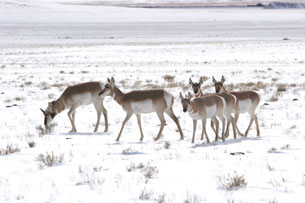Module 3 Intro
1. Module 3 Intro
1.4. Page 2
Module 3—Ecosystems and Their Diversity
 Explore
Explore
 Read
Read

© Ed Endicott/shutterstock
If you had chosen to visit Cypress Hills Interprovincial Park, in southern Alberta, you would likely see a herd of pronghorn antelope. Pronghorn antelope are a species of animals that have been given the scientific name Antilocapra americana.
species: organisms that are similar in appearance and behaviour and are able to breed with one another to produce fertile offspring
population: a group of individuals of the same species living in a specific area at the same time
community: all the individuals in all the interacting populations in a given area
This group of antelopes shown in the photograph is referred to as a population because the animals were living together in an area of Waterton National Park at the time the photograph was taken. Within Waterton National Park there are populations of different animals. These populations are not isolated and will interact with each other. These populations that interact form a community.
 Self-Check
Self-Check
SC 1. What other populations would be interacting with this population of antelopes?
 Self-Check Answer
Self-Check Answer
SC 1. Some populations that would interact with this population of antelopes are populations of grasses, bears, and white-tailed deer.
biotic: living
abiotic: non-living
The biotic components of the antelopes’ environment include all of the populations of plants and animals in the same environment. The term biotic refers to all of the living components of the environment. Some abiotic components of the antelopes’ environment include the climate, water, sunlight, minerals, rocks, and soil—the non-living components.
 Try This
Try This
TR 1. Watch an animation showing the interaction of animals and plants with the living and non-living components of the ecosystem. Make a list of the following items:
- all the biotic components
- all the abiotic components
- an example of an interaction between an abiotic and a biotic component
Put your findings into your course folder for future reference.